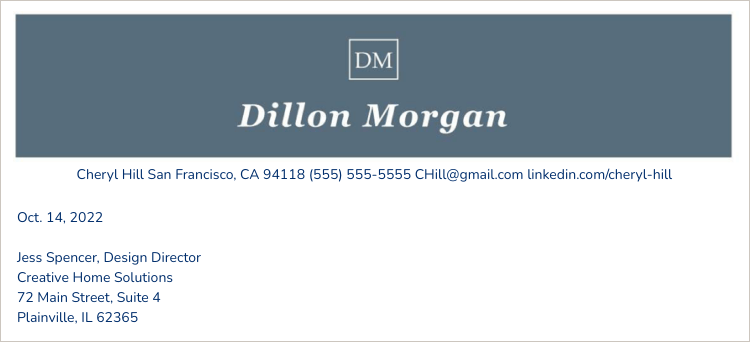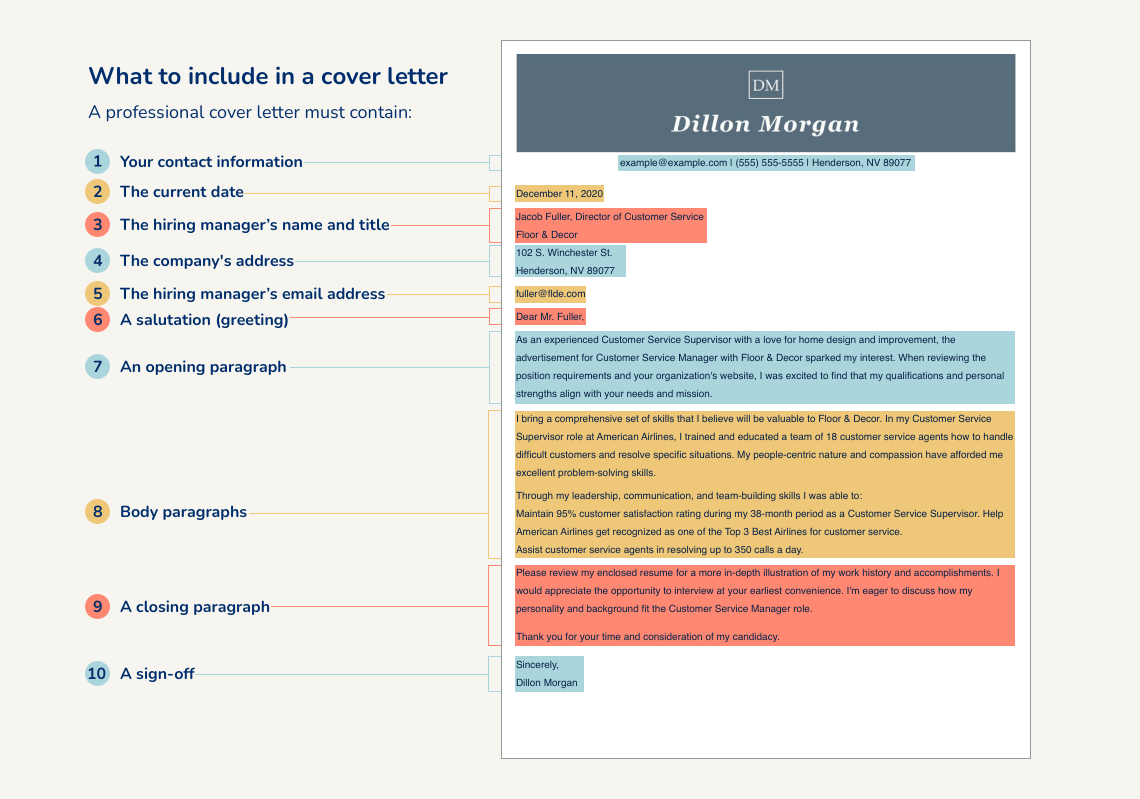By Kellie Hanna, CPRW, Career Advice ExpertLast
Updated: December 01, 2023Editor: Maria Ratcliff • Contributor: Marla Figueroa
Build my cover letter
A well-written cover letter to accompany your resume can help you stand out to employers and significantly impact a hiring manager’s decision to call you for an interview.
David Grimes, director of people and talent operations at Taulia LLC, told us, “I sincerely appreciate cover letters, as they signal to me an amplification of interest and offer an additional opportunity to convey that [job candidates] have taken the time to truly review the position or organization and see an alignment.”
He notes that “when done well, a cover letter can provide a window into the candidate as they picture themselves at our organization.”
So, if you’re wondering if you need a cover letter for a job, or you’re asking, “what is a cover letter for a resume?” and you want to know how to create a cover letter effectively, look no further!
In this guide, we’ll address the following:
What is a cover letter?
A cover letter is a one-page business document that should complement a CV or a resume in a job application. Its purpose is to:
- Introduce you to hiring managers.
- Provide details about your qualifications.
- Tell employers why you want to work for them.
- Illustrate why you’re the best match for the job.
- Explain circumstances like job hopping or gaps in employment.
PRO TIP
Did you know? 41% of job seekers replicate their resumes in their cover letters — a huge mistake. Your cover letter should complement your resume, not repeat it.
How to write a cover letter for a resume in 10 steps
Follow the simple steps below to make a cover letter that wows prospective employers.
STEP 1
Prepare to write your cover letter.
Preparation is key to writing a cover letter that stands out. Having your essential information ready will save you time and ensure you put your best foot forward.
First, review the job requirements and compare them to your relevant qualifications.
Then make a checklist of your:
- Notable accomplishments from previous jobs and volunteer work.
- Skills that match the required skills in the job ad. Include a mix of hard and soft skills.
- Educational qualifications, including certificates and licenses.
- Awards and honors.
Next, if you haven’t already, research the company to:
- Get an idea of the culture and their mission and values so you can tell the hiring manager how well you fit and why.
- Take note of the company’s news and press releases so you can highlight how you can help them reach their goals or congratulate them on a milestone.
- Learn the hiring manager’s name, so you can address your cover letter to them.
STEP 2
Choose a cover letter template
Want to know how to write the perfect cover letter? Use a cover letter template. Why? Because cover letter templates ensure your cover letter is in the correct cover letter format, they’re ATS-friendly and they are designed by professionals.
We have hundreds of templates to help you get started on the right track. Pick from modern, creative, or simple styles to match your CV or resume template and build a professional cover letter in minutes. Not sure if a template’s right for you? Try one for free!
STEP 3
Add your contact information.
Place your name, city, state, ZIP code, phone number and email address in your cover letter heading. Your email address should be professional like Jdoe@email.com and not personal like soccermom45@email.com. Include links to your LinkedIn profile or professional online portfolio if you have one.

STEP 4
Add the recipient’s address.
First, write the current date followed by a space. Then include the hiring manager’s name and title, company address and hiring manager’s email address (in that order).
It should look like this:

PRO TIP
Always follow instructions in the job ad. If an ad directs you to address your cover letter to a human resources team member or the HR department, use the information the prospective employer provides for the recipient’s address.
STEP 5
Address the hiring manager (by name).
Here’s a tip for how to address a cover letter correctly: Use the hiring manager’s name (unless the job ad specifies a department or HR team member), avoiding titles like “Mr.” or “Mrs.” unless you are certain of the person’s gender.
For example:
“Dear [hiring manager’s full name],” but if your research doesn’t turn up a name, then use “Dear Hiring Manager” or “Dear Hiring Team.” If you know their title, then write “Dear [Title].
Don’t use informal language like “Hello,” or “Hi,” or old-fashioned salutations like“Dear Sir or Madam,” or “To Whom it May Concern,” to greet the person reading your letter.
PRO TIP
Did you know? 45% of hiring managers read an applicant’s cover letter before their resume.
YES
- Dear Lucy Garcia,
- Dear Ms. Lowe,
- Dear Hiring Manager,
- Dear Vice President of Marketing,
NO
- Hi there!
- Hey Mr. Jones,
- Dear Sir,
- Sam Spade:
STEP 6
Grab the hiring manager’s attention with a powerful cover letter introduction
The opening sentences of a cover letter are like an elevator pitch. They should clearly and concisely tell hiring managers why you’re interested in the job and they’ve got to be compelling.
But how do you start a cover letter in a way that intrigues hiring managers and makes them want to read more?
The following tips and examples can help you write a cover letter opening that gets attention.
Exude confidence, passion and enthusiasm.
“I was excited to see that Tech Solutions — a company I respect for its innovation — has an opening for an experienced lead producer.”

Talk up your skills and experience.
“With seven years of experience in production for leading start-up companies in Silicon Valley, I have in-depth knowledge of cyber security and cloud computing and know my way around artificial intelligence.”

Show you’ve done some research.
Mention an interesting fact or statistic from an article, news story or the company’s website.
“When I saw that WILCO Services was touted in Business Magazine for being one of the most inclusive companies in the world, I knew I had to apply for the marketing associate position.”

- Highlight an impressive accomplishment, award or honor and use numbers when possible.
“As director of Visit Mass, I created tourism programs that resulted in a 30% increase in international tourists to Massachusetts in 2019.”

Be creative.
Tell a story about why you are applying.
“When I was a child, I spent my days in the city parks around my neighborhood, listening to birds sing and watching squirrels jump through trees. Those days instilled a passion in me for wildlife that has intensified over the years and, combined with admiration for the animal rehabilitation programs at Prospect Park Nature Conservancy, led me to apply for the Wildlife Technician position at the conservancy.”

Mention a shared contact (if you’re sure it’s a positive connection).
“Jayne Peck told me you had an opening on your graphics team, and I’m thrilled to apply for the role. You and I know Jayne from Volunteers for the Bay, where I volunteered on the cleanup crew in 2017.”

STEP 7
Explain why you’re the best candidate for the job in your cover letter body paragraphs.

The body of a cover letter should paint an in-depth picture of your professional life while providing insight into your personality. It’s your chance to show the potential employer what you’re made of.
Here’s what to write in a cover letter body paragraph, no matter your background:
- If you have work experience in your target role or industry, detail your work accomplishments and use numbers to quantify the results of your actions.
- If you’re applying for your first job, connect the new opportunity with a personal or school project, extracurricular activity or internship.
- Highlight your most relevant skills and explain clearly how you can apply them to the job.
- If you think you’re a shoe-in for the company’s culture, show it! For example, if you enjoy volunteering for social justice causes and you are applying to a nonprofit organization focused on social justice, then explain why the company’s mission is meaningful to you.
- If you’re changing careers, explain your motivation and emphasize your transferable skills to how you can contribute to the company’s success. Career change cover letters that emphasize transferable skills are more effective because they show prospectives that you can perform the work with little or no experience.
PRO TIP
Did you know? 83% of hiring managers surveyed said they would hire a candidate who sent a strong cover letter, even if their resume wasn’t up to par.
STEP 8
Write your closing paragraph.
When you write a cover letter closing statement, make it clear that you’re excited about the possibility of working for the employer and that you are confident you have the expertise to be successful at the job.
You must also thank your reader for their time and consideration, and perhaps most importantly, end with a call to action that encourages the reader to follow up with you.
Remember that you’re writing a cover letter to a specific person, so thank them for their time and consideration. You should also encourage the recipient to follow up (e.g., “I look forward to further discussing my qualifications with you.”).
Here are a few examples of how to create a cover letter closing paragraph.
I have attached my resume and creative portfolio to my application for further review of my credentials. I am eager to speak with you about this role and greatly appreciate your consideration. Please contact me at your earliest convenience to discuss my background in more detail.

Thank you for your time and consideration. I’m excited about the prospect of working for the Museum of Ancient History. I look forward to discussing what I learned in my year abroad as an English teacher and how I can apply those lessons to the docent role. Feel free to contact me any time during the week.

I’m confident that a review of my resume and portfolio will convince you that I have the technical skills and knowledge necessary to be successful in the lead designer role at Creative Ads, LLC. I’m excited about the opportunity and would be thrilled to meet with you and your team next week to discuss my ideas for your next campaign. Please contact me this week to schedule a convenient date and time.

PRO TIP
A “call to action” in your cover letter closing paragraph shows hiring managers that you’re serious about the job and confident in your qualifications.
STEP 9 Sign off.
What goes in a cover letter ending isn’t complicated, but you have to get it right if you want a chance at the job.
That means you must be respectful, polite, professional and formal.
YES
- Sincerely,
- Best regards,
- Kind regards,
- Thank you,
NO
- Yours,
- Take Care,
- Cheers,
- Thanks!
STEP 10 Proofread your cover letter
Knowing how to write a cover letter for a job isn’t all there is to making a cover letter. You have to proofread it at least once before sending your job application letter to a potential employer. Typos and cover letter formatting mistakes can reduce your chances of getting hired. When you’ve finished proofreading, have someone else read it for you too, just to be sure it’s job application-ready.
And there you go! That’s how to write a good cover letter.
What should a cover letter look like?
All cover letters follow a basic business letter structure that looks like this.

Cover letter writing checklist
- Template
- Did you choose a cover letter design that matches your resume?
- Contact information
- Are your name, location, phone number and email address up to date and displayed at the top of your cover letter?
- Did you add a link to your professional portfolio or website and your current LinkedIn profile (if you have them)?
- Date
- Did you add the current date at the top of your cover letter?
- Company information
- Did you address your letter to the hiring manager by name and include their title, email address and the correct company address?
- Salutation
- Did you greet the hiring manager, recruiter or HR associate by name or title?
- Did you use a polite but formal greeting?
- Opening paragraph
- Are the first few sentences of your cover letter clear and compelling?
- Do you convey enthusiasm for the job?
- Body paragraphs
- Did you effectively express how you can apply your skills, experience and achievements to the target job to help the company achieve its goals?
- Did you highlight one or two things you like about the company, such as their values or culture, and why?
- Closing paragraph
- Did you thank the reader for their time?
- Did you end your cover letter with a call to action?
- Sign-off
- Did you use a proper, formal closure to end your letter?
How to make a cover letter fast
A professional cover letter template is the best place to start a cover letter.
Job-specific phrases and skills: No matter the job you’re applying for, we give you the right words and relevant skills you can incorporate with just one click.
- Step-by-step guidance: Get expert advice at every step to help you present your best self and get the job.
- Easy customization: Write a cover letter for every job application and save as many versions of it as you need.
- Multiple download formats: Save and export your cover letter as a PDF, DOCX or plain text.
PRO TIP
Always match your cover letter template to your resume template for a polished job application.
Cover letter tips
We’ve given you almost all the advice for writing a good cover letter that you’ll need to start creating a cover letter, but we’ve saved a few pointers for last.
Here are our top five tips for how to make a cover letter effectively.
- TIP #1
Follow instructions. This is probably the most important tip for writing a cover letter. Read the job description carefully and do what it says. If the job posting says to send your letter as a PDF, don’t send a Word document. If it tells you to send your cover letter as an email attachment, then do so. If the job posting says to write your cover letter in the body of an email, then do that. If you fail to follow all instructions in a job ad, you will likely not be considered for the position. - TIP #2
Tailor your cover letter to the job. Hiring managers know a generic cover letter when they see one — and they usually ignore them. That’s why it’s critical to customize your cover letter to show your enthusiasm for the specific job and company you’re applying to. To do this, use keywords from the job description when they apply to you. Doing so also ensures ATS software can find you and signals to hiring managers that you meet their requirements. Our Cover Letter Builder makes it fast easy to customize a cover letter for every job you target. - TIP #3
Don’t apologize. Never point out the skills and experience you lack. If you are qualified for the job but don’t have much experience in the field, don’t apologize. Instead, focus on experiences like volunteering, school projects and community service you’ve done that make you a good fit and play up your transferable skills. - TIP #4
Don’t overshare. While writing a cover letter to explain a career change or job gap is a good idea, sharing every detail about your life or career is not. Keep away from the following topics every time you create a cover letter:- Political views.
- Current or past salary or salary expectations for the target job.
- Exaggerations and lies (about anything).
- Personal details such as marital status, family background, financial situation, ethnicity or religious beliefs
- Negative thoughts about your former boss, company or coworkers.
- Irrelevant personal hobbies.
- Details about work from more than three years ago that doesn’t pertain to your target job.
- TIP #5
It’s possible to be too enthusiastic. We stress the importance of conveying enthusiasm when you write a cover letter because you should. However, use caution when displaying your zeal. Keep your tone professional, be genuine and never present yourself as desperate.
How to write a cover letter: important takeaways
Let’s recap the basics of what to include in a cover letter one more time:
- A cover letter is a one-page document that complements your resume without repeating it.
- Address the cover letter to the hiring manager. If you don’t know who to address the cover letter to or can’t find their name, then address them as “Hiring Manager,” by their title, or address the department.
- Write a cover letter introduction that immediately grabs the hiring manager’s attention and compels them to keep reading.
- It’s a good idea to use a professionally designed cover letter template to ensure your cover letter is formatted correctly.
- A good cover letter is a custom cover letter. Tailor yours to your target job and use keywords from the job description if they fit your abilities.
How long should a cover letter be?
A cover letter should cover one half-a page minimum and it should never be more than one-page long. Aim to concisely express your points in about 250-500 words.
Editor: Maria Ratcliff • Contributor: Marla Figueroa

Kellie Hanna, CPRW
CAREER ADVICE EXPERT
Kellie is a Certified Professional Resume Writer with 20+ years of experience in digital media and is passionate about helping job seekers navigate their careers. She earned a B.A. in English and writing from Temple University.


